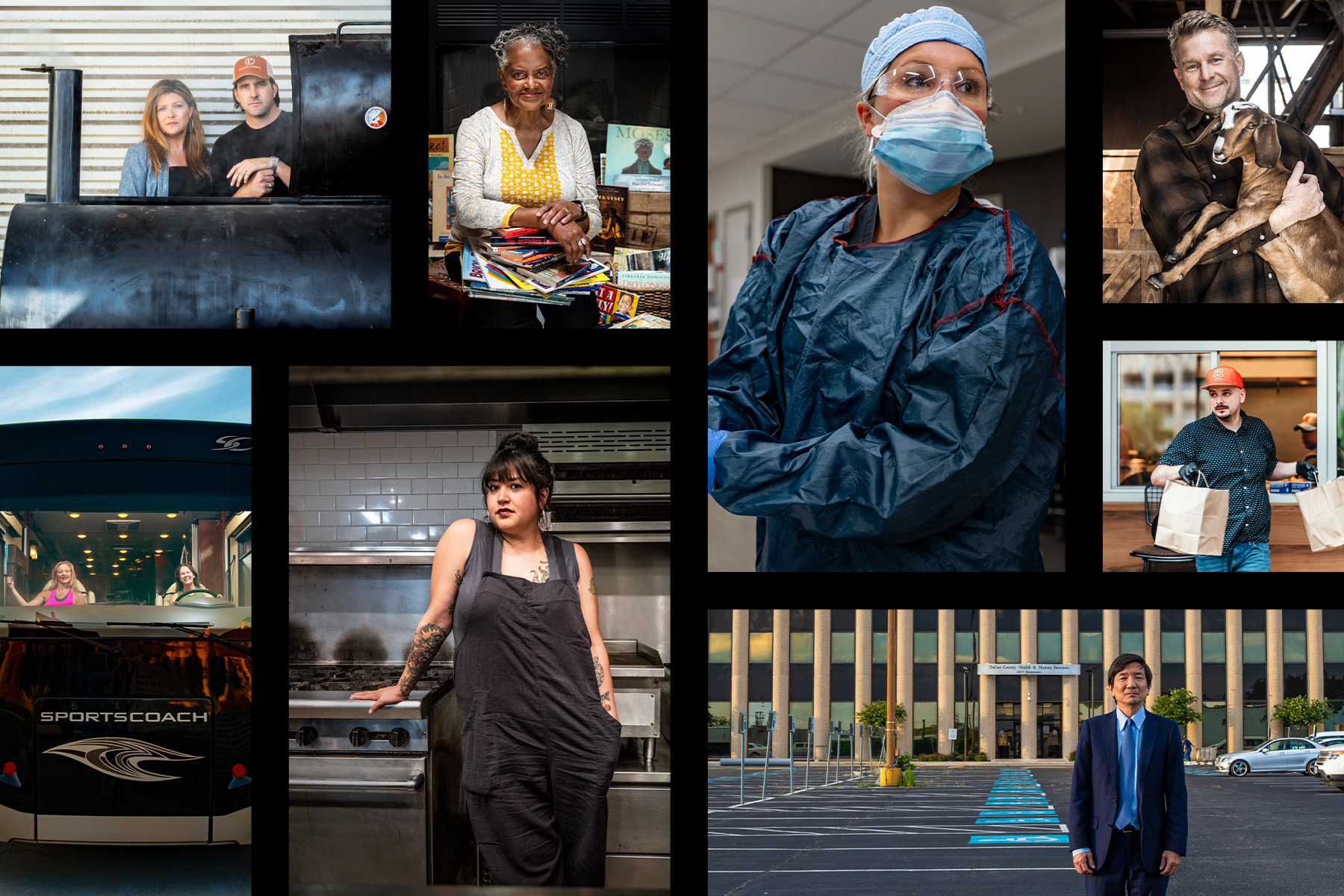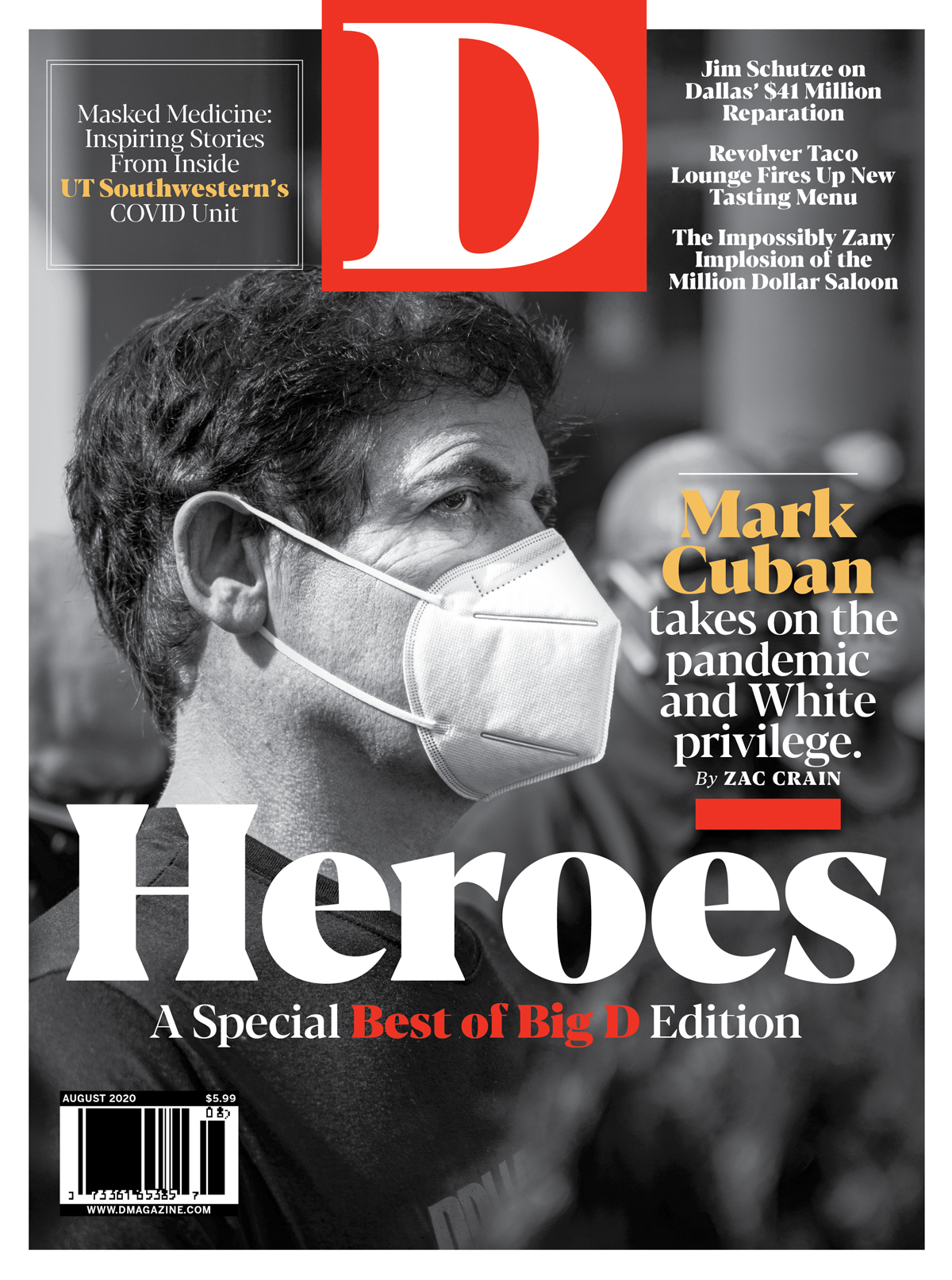Since 2020 has been a year like no other in our history—we weren’t around for the last global pandemic, in the early 1900s—we knew we had to approach our annual Best of Big D issue in a different way. We threw out the usual categories and asked readers to nominate people they considered heroes, men and women who had stepped up during this crisis to protect and serve. We had no shortage of candidates: doctors, lawyers, students, makers, RV procurers, video producers, farmers, feeders, letter carriers, leaders. More than 900 submissions in all. It was difficult to narrow it down to the names you will soon learn about. We applaud them all. You should, too.
Service
Will Salisbury
Heard That Foundation
Formerly sous chef at the high-end french brasserie Bullion, Salisbury co-founded Heard That Foundation, a nonprofit dedicated to raising funds for hospitality workers with urgent medical concerns. But when the pandemic struck Dallas, those needs became more dire. The scrappy nonprofit, which also functions as an information hub and advocate for issues like health insurance and paid leave, evolved as the situation did. First, it provided microgrants to bartenders, baristas, servers, and dishwashers to offset rent, utilities, or healthcare costs. Then it created Staff Meal, a program staffed entirely by hospitality industry volunteers cooking dinners five nights a week for their own service-industry family. And, finally, it offered weekly farmer’s bags filled with milk, goat cheese, and produce from local farms like Profound Foods. Active and fiercely committed, Heard That proved a linchpin in the effort to aid a struggling industry looking to uplift its own.
Patrick Brandt and Anurag Jain
Get Shift Done
Brandt and his company Shiftsmart joined Jain, entrepreneur and chairman of the board of the North Texas Food Bank, to launch Get Shift Done, a nonprofit initiative that linked furloughed or unemployed restaurant-industry workers with volunteer shifts at food banks, food pantries, schools, and food-distribution nonprofits. By mid-June, Get Shift Done had provided temporary jobs and paychecks for 11,000 hospitality workers, served more than 18 million relief meals, and spread its model beyond North Texas to other states.
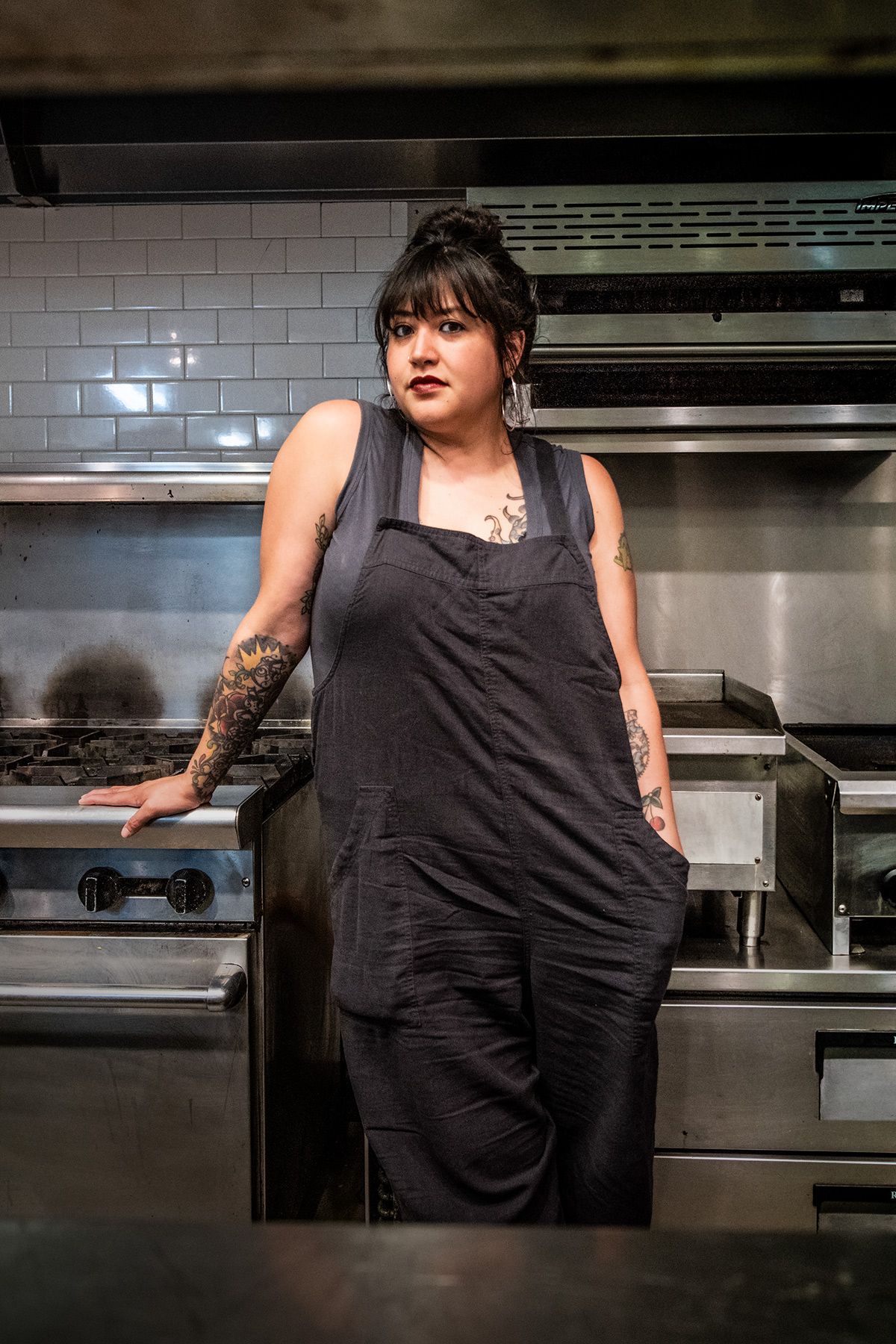
Diana Zamora
Project La Familia
Seeing a need when DISD discontinued its free meals for school children, Zamora launched Project La Familia, creating one-pot meals and snacks for students and their families facing food insecurity. The organization received donations from various sources and was staffed by unemployed or furloughed restaurant industry workers.
Elias Pope
Everybody Eats
Pope, founder of 80/20 Hospitality (HG Sply Co., HERO, Standard Service), created Everybody Eats to provide free meals to anyone laid off in the service industry or other business. With the help of Chefs’ Produce, Heard That Foundation, and others, the curbside meal pickup operation functioned out of HG Sply Co. on Lowest Greenville and HERO in Victory Park and provided tens of thousands of free meals.
Richard Torres
Chefs’ Produce
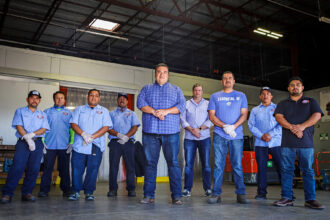
workers at cost.
Torres, vice president of his father’s Houston-based wholesale produce business, which has served Dallas restaurants since 1994, found himself at the center of an industry that had ground to a halt. He wanted to find a way to stanch the bleeding wounds of product loss and employee layoffs. The solution crystallized around produce boxes, which he sold at cost from his warehouse to service-industry employees who had been laid off or furloughed when their restaurants shuttered.
The first week, he sold more than 1,000 of them, as lines stretched down the street. Anyone who couldn’t cover the $30 fee still went away with full arms. As demand grew, Torres and his employees expanded their service to retail customers, offering pickups at various locations, all restaurants, setting up in parking lots and selling boxes loaded with produce, eggs, milk, bags of jasmine rice, bread, and other products from local vendors who were struggling. Ten dollars from each sale went to the employee relief fund of whichever restaurant hosted the pop-up—José on Lovers, Taverna Rossa, Homewood, RM 12:20 Bistro, and others—or to HG Sply Co.’s Everybody Eats fund.
As restaurants reopened in May, the company shifted back to serving them, having sold more than 10,000 boxes to nonindustry folk and thousands of boxes to service-industry employees.

Randy Dewitt
Furlough Kitchen
Along with Jordan Swim of Vestals Catering and the nonprofit CitySquare, DeWitt, who is the CEO of Front Burner Restaurants, spearheaded Furlough Kitchen, a pop-up that served lunch box-style pickup meals Monday through Saturday for anyone laid off in the service industry.
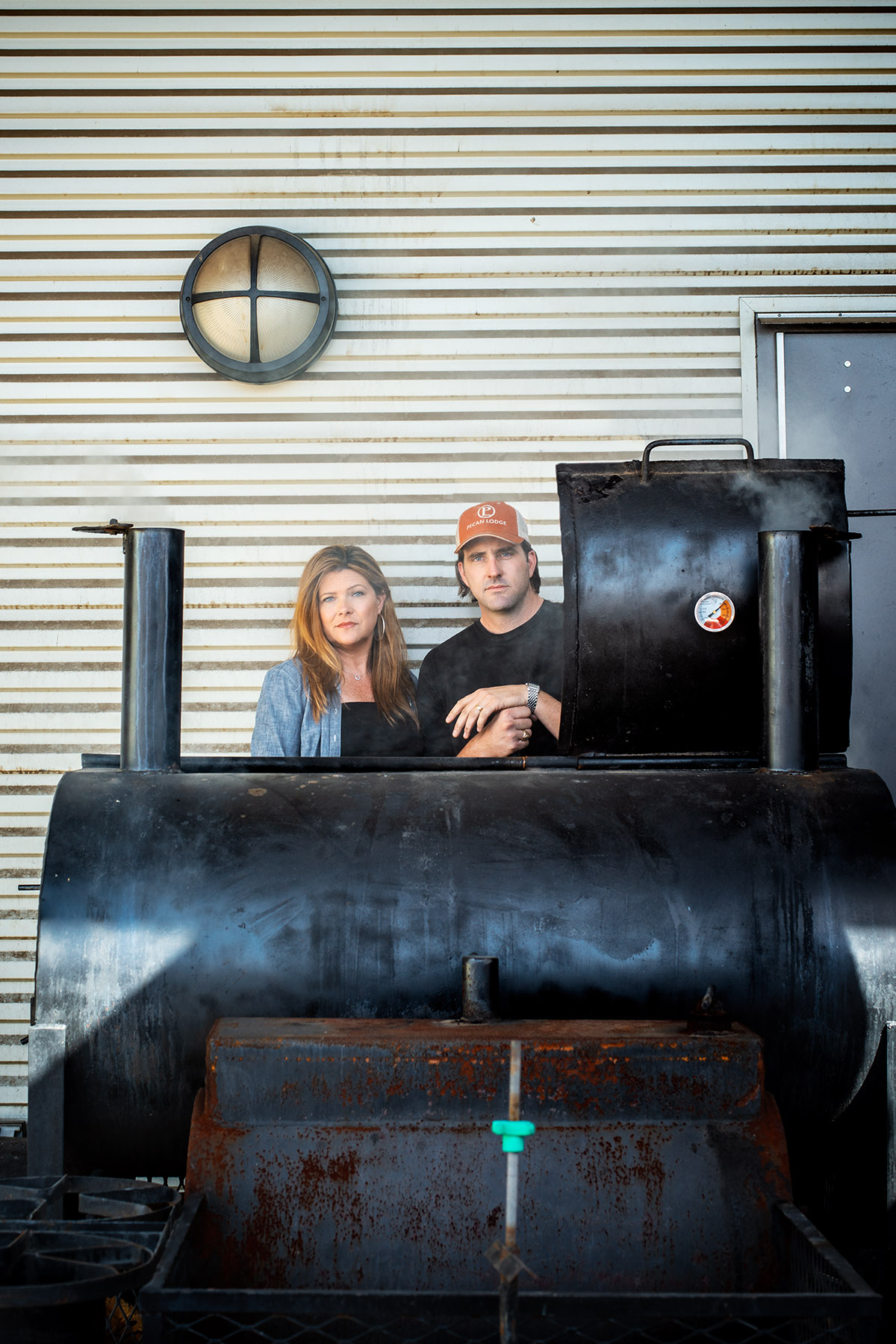
Diane and Justin Fourton
Pecan Lodge
To the husband-and-wife owners of pecan lodge in Deep Ellum, the onslaught of COVID-19 felt eerily similar to the 2008 economic crisis. “It was really scary in that moment,” Justin says. “You went from everything being OK to 90 percent of business evaporating overnight.” But they were determined to “give back to Dallas everything it’s given us,” Diane says.
So the couple launched The Dinner Bell Foundation to do what they do best: feed people. They’ve provided free meals to hospital workers, nursing home staff, firefighters, and other frontline workers in need. They’ve served more than 15,000 meals as of press time. The foundation also partners with local restaurants to buy their food, keep staff employed, and provide financial assistance. “It’s difficult to be in this industry but maybe more rewarding than ever,” Diane says. “It’s healing.”
Amy and Nick Bonanno
Curbside Ninja
The website development entrepreneurs were determined to help alleviate profit-loss woes they heard about from restaurant-owning clients and friends. Many were losing significant income—sometimes upwards of 30 percent on each transaction—to third-party services as they shifted their businesses to takeaway and delivery models. So the Bonannos secured a grant from RevTech Ventures, a Dallas-based startup accelerator, and launched Curbside Ninja, a curbside pickup and delivery platform. They were awarded the grant in early April, and, with a prototype ready to go, they were able to help restaurants turn on a new revenue stream. The duo has been providing the service free of charge to restaurants during the pandemic.
Rosey Sullivan
Undocumented Workers Fund Dallas
Early on, Sullivan, Armoury D.E.’s general manager, recognized an enormous concern for employees of the hospitality industry: none of the federal and disaster-related funds would be filtered to undocumented workers, many of whom work in Dallas’ food and beverage industry. Sullivan put together the Undocumented Workers Fund Dallas to help those workers who aren’t eligible for unemployment benefits. She built a website, attached an online payment system to Venmo, and began taking donations and passing them out to applicants in the form of small grants.
Chad Houser
Cafe Momentum
Having closed its doors, the socially active nonprofit restaurant inaugurated an initiative it called Momentum E.A.T.S. (Engage. Act. Transform.), providing meal kits to food-insecure families affected by school closures. Funded by donations and prepared by the program’s youth interns, the 25,000 weekly meals reached Dallas and Richardson ISD students as well as private academies and nonprofits. The interns glowed, Houser says, “to be the kids who were stepping up.”
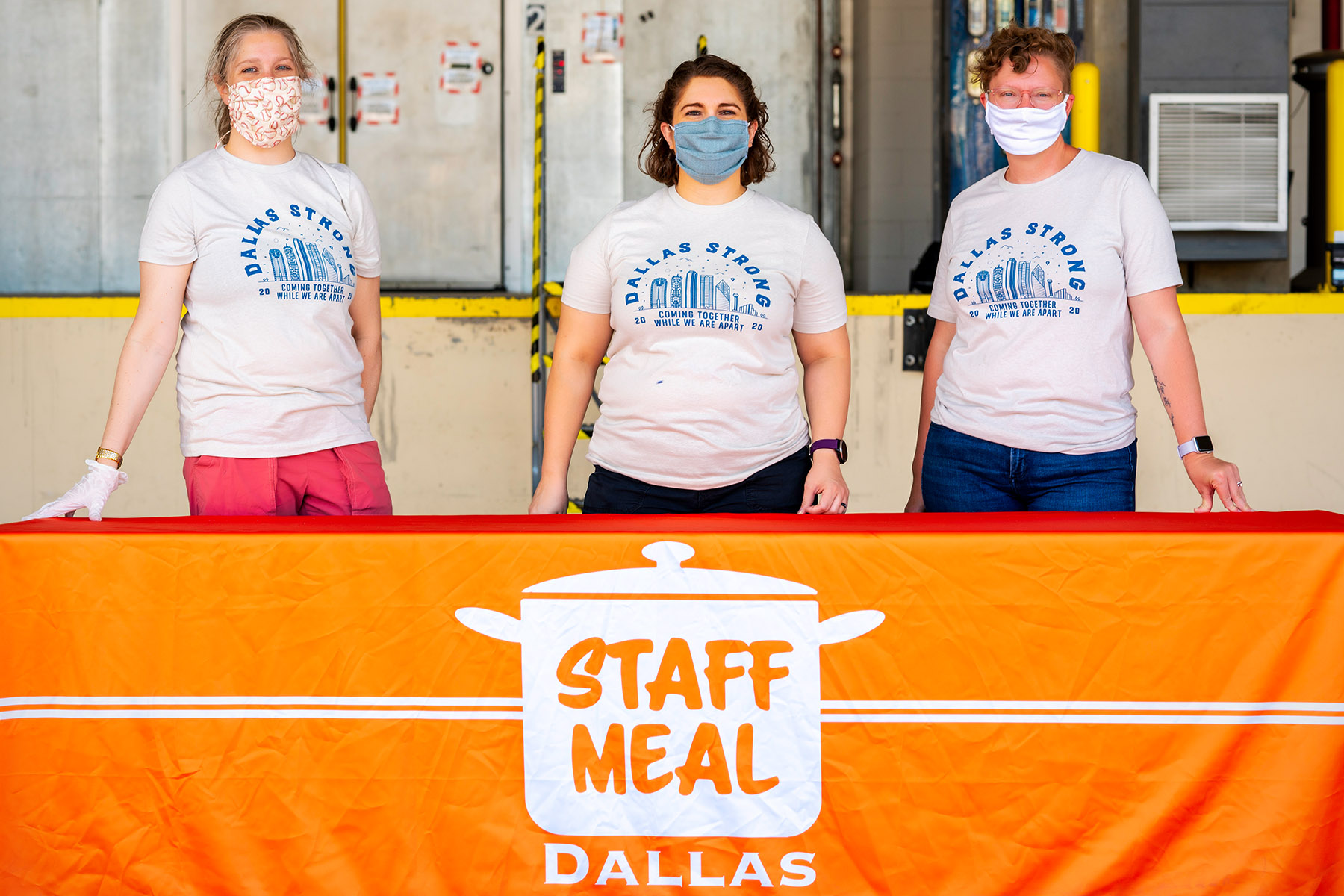
Staff Meal
The nonprofit FestEvents Foundation established the Staff Meal program for unemployed hospitality workers in collaboration with Steve DeShazo, director of culinary programs at Dallas College (formerly El Centro), and chefs Nick Walker (Virgin Hotel Dallas) and Sharon Van Meter (3015 at Trinity Groves). Saturdays became pickup days for free meal packs that included four breakfasts and four lunches or dinners. In July, as more restaurants opened, a new phase was started for family meal pickups from a different designated restaurant every week.
Joe Groves
Ellen’s
As the food sector saw record job loss, Groves, who co-owns Ellen’s restaurant downtown, kept every employee on payroll and covered lost income from tips. He sent out stick-to-your-ribs meals to first responders. And for every Ellen’s gift card purchase, Groves matched the same dollar amount for donated meals to an economically underserved area in southern Dallas.
Community

Emma Rodgers
Storytime at Bedtime
Rodgers, a retiree who used to own Black Images Book Bazaar in Oak Cliff, decided to help both children and parents cope with the pandemic. She created a series of YouTube videos with the Bishop Arts Theatre titled “Storytime at Bedtime” to entertain kids and provide relief for overworked parents. Since its founding, the project has grown to include submissions from authors around the country, spanning from Connecticut to California. “Reading is a wonderful way to travel the world or just to escape,” she says. Beyond this project, Rodgers is also an active volunteer, working with the Dallas Civil Rights Museum and serving on the community advisory board for UT Southwestern Medical Center’s DFW COVID-19 Prevalence Study. #batcstorytime
Eli Cohn-Wein
Jewish Community Center of Dallas
Even before COVID-19 hit, executive chef Cohn-Wein and his small crew fed hot, kosher lunches to seniors in need at the Jewish Community Center on weekdays. When Dallas’ shelter-in-place order went into effect, the team switched to making frozen meals that gloved and masked volunteers would put directly into seniors’ cars regardless of religion. They’ve distributed 13,000 meals to 250 seniors and counting.
Danaë Bibiana Gutiérrez Martínez
Harvest Project Food Rescue
You’ve heard of startups that save “ugly” or “imperfect” produce from the garbage bin. Martínez did it before it was trendy to disrupt food waste streams. Since 2014, as the executive director of Harvest Project Food Rescue, Martínez has distributed surplus, often unpretty, produce to food-insecure communities. Now the nonprofit is serving double—and, at times, triple—the number of families seeking healthful food.
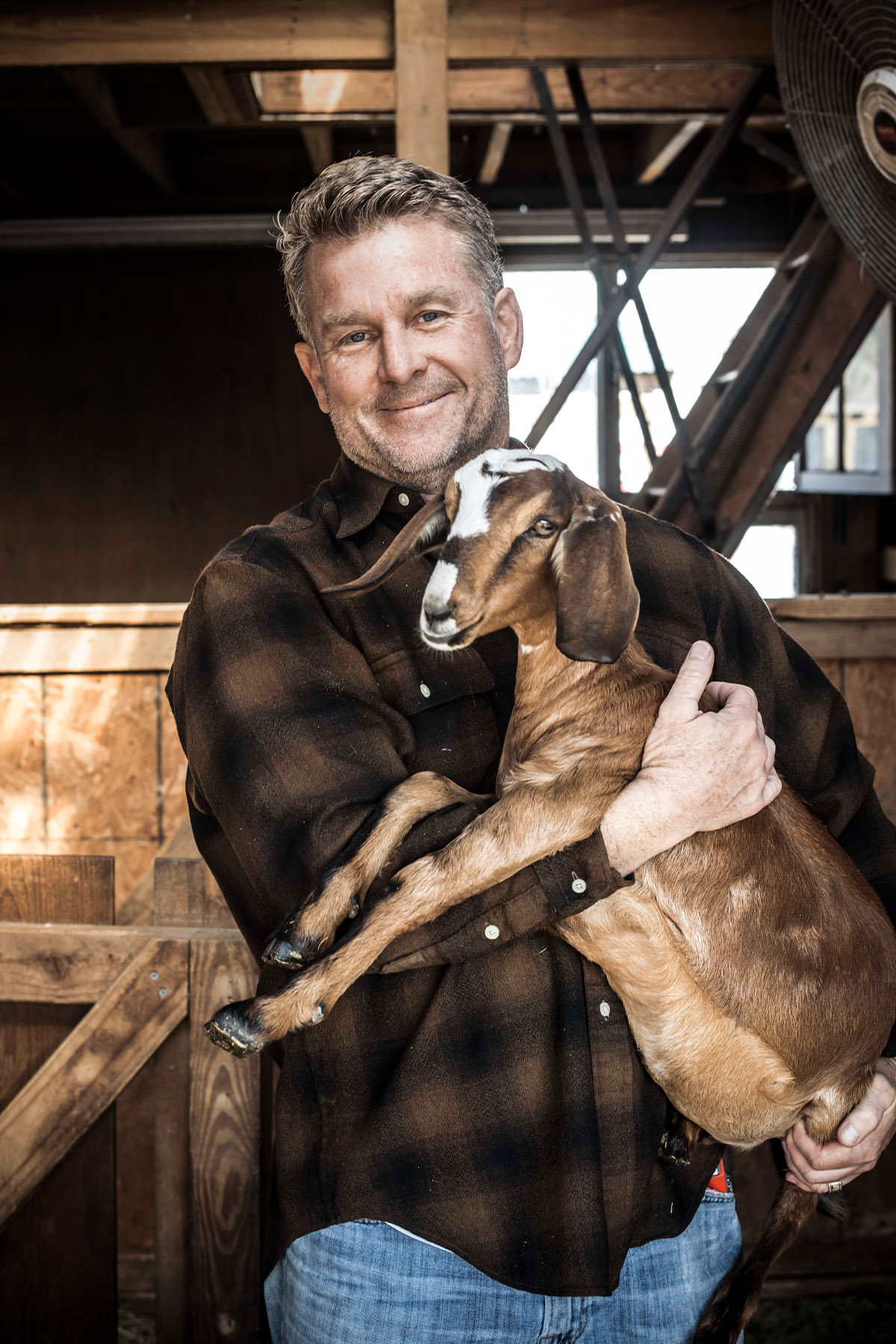
Daron Babcock
Bonton Farms
When Babcock started Bonton Farms in South Dallas, five years ago, the nonprofit’s mission was built around stability and hope. And when the world shut down, his mandate to feed the community and keep people employed didn’t change. “It required this shift where we’re urgently providing basic staples to people who have seen job losses, hours cut, and kids’ feeding programs at schools being cut,” he says.
Situated in a food desert, the urban farm’s market serves nourishing meals to those whose trip to the nearest grocery store may take hours using public transportation. And now, without restaurants to sell its produce to, Bonton Farms has launched a new farmers market where folks can purchase fruits, vegetables, and meats. Babcock says they feed 100 families weekly and are working to serve 150. “We really take great joy in serving people that the world had given up on in a lot of regards,” he says.
North Texas Food Bank
By April, it wasn’t hard to find physical markers from the invisible pandemic. But the most shocking was the line of cars outside Fair Park—so long it could circle the entire 277 acres one and a half times—filled with hungry people, some of whom had lined up the night before. The North Texas Food Bank had 4,000 boxes of food to give away. They were gone by lunchtime. Since March 15, the NTFB has provided more than 38 million pounds of food. They partner with 262 agencies in 13 North Texas counties. They’re handing out boxes up in Plano and down at the UNT-Dallas campus, near I-20. About 70 percent of recipients were first-timers, meaning a distribution center that may have had 300 clients in February suddenly had 1,000 in a matter of months. Through it all, the North Texas Food Bank has been the supplier, loading box after box into car after car, restocking shelves at nonprofits in West Dallas and Oak Cliff. As long as there is need—and there always will be need—they can be counted on.
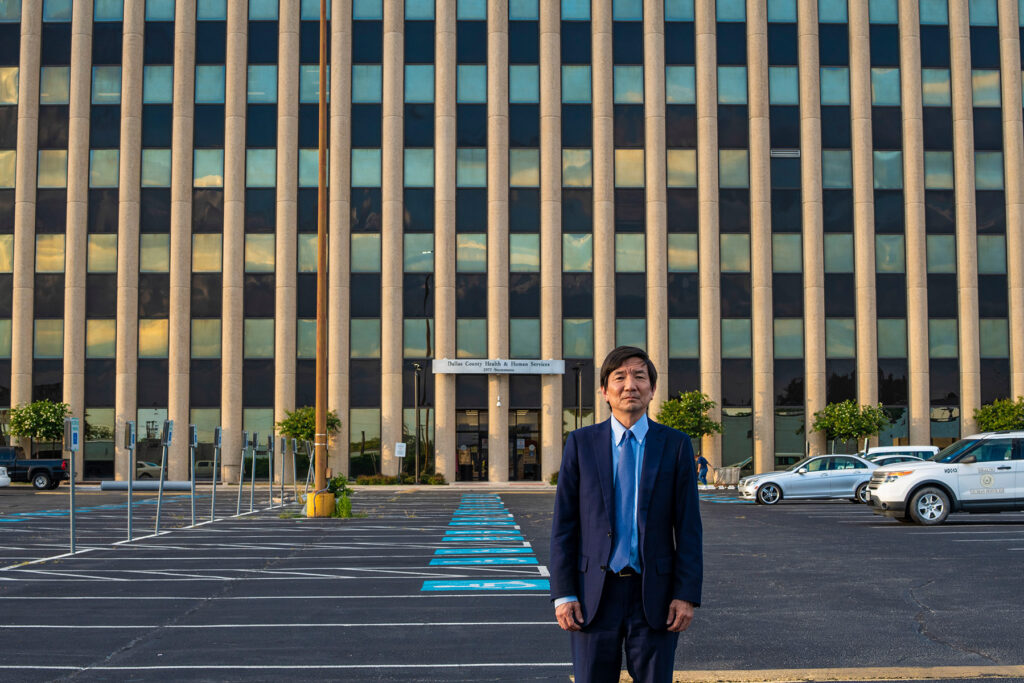
Philip Huang
and the Dallas County COVID-19 Response Team
When Dallas County Judge Clay Jenkins began to organize his COVID-19 response team in early March, he looked for people from diverse backgrounds with varied skill sets who could address the myriad ways the pandemic would disrupt day-to-day life. He would need health and legal experts, people with experience setting up supply chains and expanding the county’s medical equipment capacity, communications specialists, emergency response managers, and business leaders. Moreover, all these people would need to be willing to work punishing hours in a high-stress environment.
To his tireless staff of Lauren Trimble, Ruby Blum, Shay Cathey, and Jheison Romain, he added Philip Haigh, his former chief of policy, who worked weekends to allow the core team time off. Doug Bass, whom team members called The Chief, ran the county’s Office of Homeland Security and Emergency Management with Lisa Tatum Brown. Katy Womble headed up a legal brain trust—which also included volunteer lawyers Debbie Branson and Tex Quesada—that drafted the county’s orders, including the controversial shelter-in-place order. Dr. Brian Williams helped craft the Mass Critical Care Plan, and Peter Urbanowicz served as the hospital response czar, coordinating with all the area hospitals as well as FEMA and HHS.
Jenkins leaned on Huang not only for scientific data and medical guidance but also for the confidence and stability projected by Huang’s unflappable demeanor.
Jack Martin, who is on the board of Baylor Scott & White, served as a liaison with the business community, working to expand ventilator capacity and chairing Jenkins’ economic recovery task force. The judge tapped former Dallas ISD school board chair and mayoral candidate Miguel Solis to assist with intergovernmental coordination and create supply chains and partnerships to expand PPE capacity, and he hired Patricia Nova to help coordinate those efforts with the county’s existing technology and purchasing systems. The judge also brought on Elisa Hernández, formerly with the Dallas Regional Chamber, to manage communications; Rebecca Acuña, who volunteered to manage Spanish-language communications; and Eugenia Castañeda, who served as chief Spanish-language translator.
At the center of the entire operation was Dr. Philip Huang, the director of Dallas County’s Health and Human Services Department and the judge’s right-hand man. Jenkins leaned on Huang not only for scientific data and medical guidance but also for the confidence and stability projected by Huang’s unflappable demeanor. Managing a pandemic response is a thankless endeavor that requires navigating constantly shifting information, evolving medical guidelines, changing state and federal regulations, and demoralizing political headwinds. But early on, Jenkins and Huang committed to a simple approach. “We need to be able to look at ourselves at the end of this,” Huang says, “and say we did the right thing and we saved lives.”
Barbara Johnson
Hope Supply Co.
Johnson is one of the founders of Hope Supply Co., the largest children’s diaper bank in Texas. The company partners with more than 75 nonprofits in seven counties in North Texas, including homeless shelters, domestic violence shelters, foster care programs, and diaper pantries. Critical supplies provided include diapers, wipes, hygiene kits, formula, and baby food, helping to reduce the financial stress on families in need. Due to the economic impact of COVID-19, the need for diapers has increased three times over, and the company has begun serving entirely new groups of people who were not in need before the pandemic.
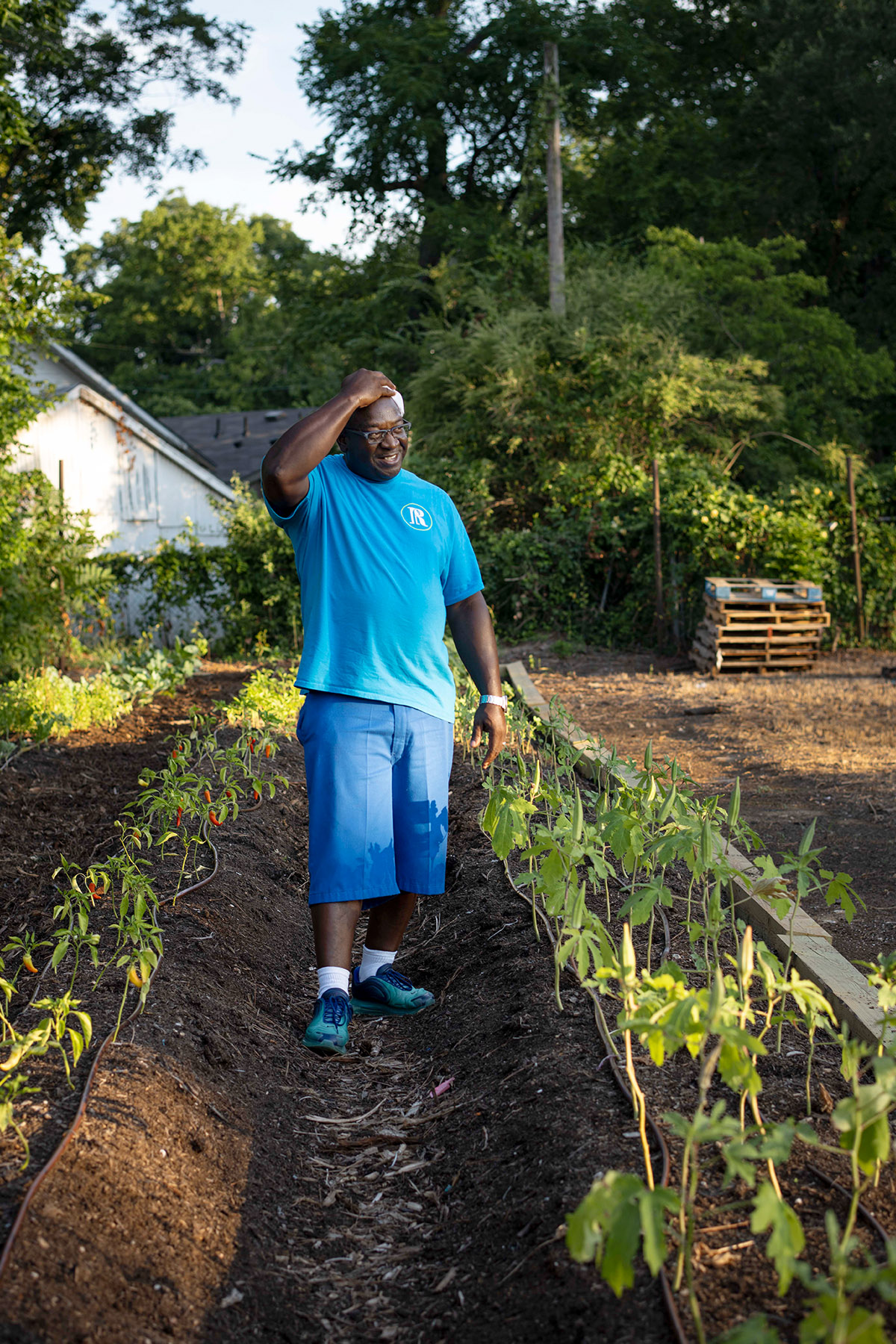
Tyrone Day
Restorative Farms
Over the past three years as Restorative Farms’ system manager and lead horticulturist, Day has been slowly but surely cultivating a new crop of urban farmers across the city of Dallas. The organization, which has a seedling and training farm in South Dallas, aims to provide relief in food deserts by donating fresh produce and teaching residents how to cultivate their own food.
For Day, the mission is personal. He was born and raised in South Dallas and grew up working on his grandma’s small farm. After being wrongfully convicted, Day revisited his passion for farming while imprisoned, graduating top of his class at Trinity Valley Community College with a degree in horticulture and working in the prison greenhouse for 19 years. Upon being released and seeing the great need for fresh produce in his community, he took it upon himself to make a difference.
So far, Day has worked with Restorative Farms to donate more than 40,000 plants to community gardens, and with the recently launched GroBox program, they’ve donated 220 portable gardens to the community.
Jeannie Barsam
Gifting Brands
For high-end retailers, liquidating excess and out-of-season inventory without devaluing the brand has always been a challenge. Gifting Brands was created to offer a sustainable and charitable alternative to destroying excess goods. Retail companies donate their products in exchange for tax benefits, and the pieces are then sold at a slight discount on Gifting Brands’ online platform. All of the profits are donated to local and national charities. The concept was created by Barsam, a retail veteran who once held leadership roles at The Gap and Zales. The company launched in April, and profits are already providing much-needed support to Dallas charities. The Family Place, which provides safe housing for domestic violence victims, was the first to receive funding. “We needed to be able to help every person who called us, especially during a frightening time of confinement at home,” says Paige Flink, The Family Place CEO. “The funding from Gifting Brands [immediately helped us] save lives.”
North Texas Cares
For understaffed and overworked nonprofits, applying for multiple grants to deal with depleted resources during the pandemic was a herculean task. In response, 31 of our region’s biggest foundations, such as Communities Foundation of Texas and United Way, joined forces. North Texas Cares was created to offer support to nonprofits that serve vulnerable communities affected by COVID-19. Instead of spending days applying for emergency grants, nonprofits can submit a single application, which is then sent to all 31 funders for consideration. Over $98 million in emergency grants has been requested, and over $35.5 million has been distributed. “I am so grateful for the efficiency North Texas Cares provided,” says Kevin Pranoto of Mission Oak Cliff. “I couldn’t imagine how we would have fundraised in the midst of the pandemic. We received [grants] from four funders, and that gave us the time and resources to continue doing the work we are devoted to.”
Bill Holston
Human Rights Initiative
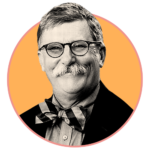 Holston has saved our sanity more than once with his “Law Man Walking” column for D Magazine’s blog, showing us where to find the many byways less traveled than the Katy Trail. But between hikes, his day job as a human rights attorney hasn’t let up. The government is still pursuing deportations, and people are still fleeing torture, persecution, and abuse on a global scale. “The most dramatic change has been the social service needs of our clients,” Holston says. “They were significantly impacted by the layoffs and inaccessibility to benefits. They don’t qualify for stimulus funds or unemployment. They were in very desperate circumstances very quickly.” Holston and his staff of 16 started soliciting donations, looking beyond the legal needs of their clients to provide direct aid for groceries, utilities, rent assistance, and toiletries.
Holston has saved our sanity more than once with his “Law Man Walking” column for D Magazine’s blog, showing us where to find the many byways less traveled than the Katy Trail. But between hikes, his day job as a human rights attorney hasn’t let up. The government is still pursuing deportations, and people are still fleeing torture, persecution, and abuse on a global scale. “The most dramatic change has been the social service needs of our clients,” Holston says. “They were significantly impacted by the layoffs and inaccessibility to benefits. They don’t qualify for stimulus funds or unemployment. They were in very desperate circumstances very quickly.” Holston and his staff of 16 started soliciting donations, looking beyond the legal needs of their clients to provide direct aid for groceries, utilities, rent assistance, and toiletries.

Lynn Pride Richardson
and the Dallas County public defender’s office
The attorneys in the Dallas County Public Defender’s Office, led by Richardson, have been risking their health and safety representing indigent clients housed in the Dallas County Jail. They have made it their priority to attempt to obtain the release of low-level, nonviolent offenders to protect them from unnecessary exposure to the coronavirus, which is now prevalent in the Dallas County jail system. Richardson and the members of her office have also partnered with criminal justice advocacy groups and bail funds to get inmates who cannot afford to post even minimal bonds released from jail.
Lola Lott
CharlieUniformTango
The Woodrow Wilson High School Performing Arts program has a long-standing and very proud musical tradition that spans six decades, and this year’s production of Mamma Mia! would have marked the 63rd season. As with many other events, the COVID-19 pandemic closed the curtain on the program. As parents, teachers, and kids scrambled to find an outlet for creativity, the program received a boost from CharlieUniformTango, a post-production house whose owner, Lott, found out the school was looking for ways to do a video in isolation. She offered her resources to help. The professional producers and video and audio engineers, along with a few parent volunteers, spent a week turning the kids’ isolation videos into a performance that captures the love of community, arts, and musical tradition. The eight-minute virtual musical has more than 65,000 views and 600 shares on social media.
Mark Melton
Holland & Knight
 A corporate tax attorney by trade, Melton says he became an expert on landlord-tenant law “mostly by accident.” After posting some basic information about the eviction process on Facebook, he was overwhelmed by the number of requests for assistance. So he recruited a team of more than 100 volunteer attorneys, and his wife went to work managing intake on her laptop at home. Then he figured he’d better draft a whole new eviction ordinance for the city to address the current situation—one that was fair to all parties and would pass constitutional muster. To date, his team has assisted close to 2,000 clients, and they don’t have plans to stop anytime soon. “We’ll probably keep going for a while,” he says. “We wanted to address a crisis, but I think we’re still in the crisis. Just because some of the stay-at-home ordinances have been lifted, we still have people who have been without work for two or three months or more. You can’t flip an economic switch and change all that.”
A corporate tax attorney by trade, Melton says he became an expert on landlord-tenant law “mostly by accident.” After posting some basic information about the eviction process on Facebook, he was overwhelmed by the number of requests for assistance. So he recruited a team of more than 100 volunteer attorneys, and his wife went to work managing intake on her laptop at home. Then he figured he’d better draft a whole new eviction ordinance for the city to address the current situation—one that was fair to all parties and would pass constitutional muster. To date, his team has assisted close to 2,000 clients, and they don’t have plans to stop anytime soon. “We’ll probably keep going for a while,” he says. “We wanted to address a crisis, but I think we’re still in the crisis. Just because some of the stay-at-home ordinances have been lifted, we still have people who have been without work for two or three months or more. You can’t flip an economic switch and change all that.”
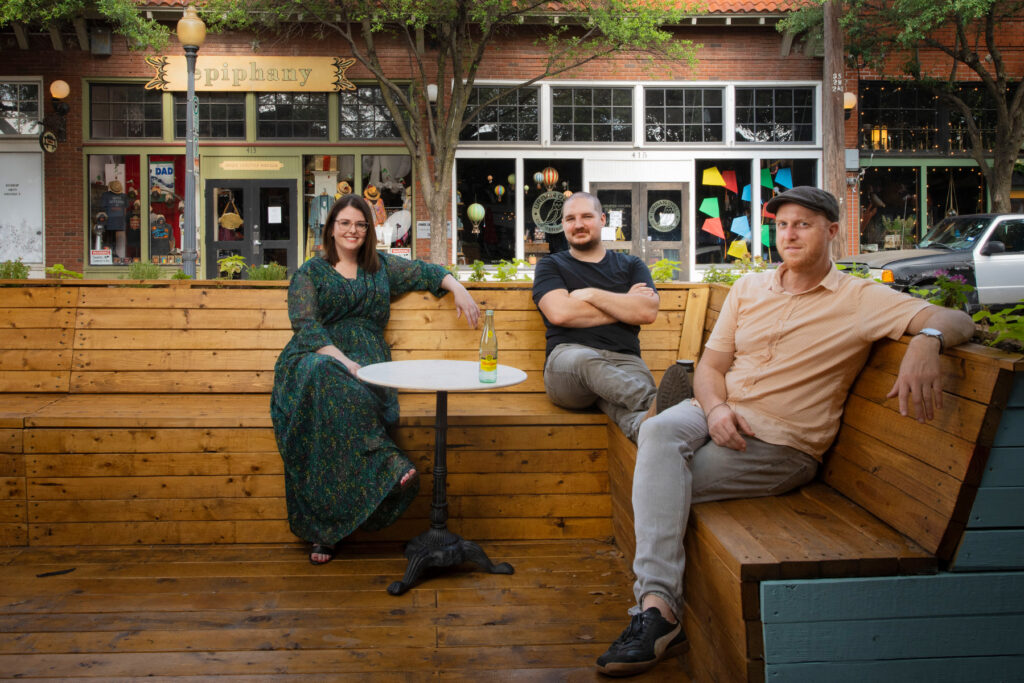
Krista Nightengale
and the Better Block Team
During the first days of the pandemic lockdown, the urban activists with Better Block, including Nightengale, the group’s managing director, shifted from staging conceptual demonstrations of improved environments to making real-life changes that could support struggling businesses and sheltered residents. They lent wooden market stalls to an Oak Cliff restaurant to transform it into a pop-up outdoor market. They turned their fabrication studio into a PPE manufacturer. They created a “parklet” model that reclaimed street space to provide socially distanced outdoor seating. They worked with the city to create a program that allows neighborhoods to shut down streets to traffic and create more recreation space. When the pandemic subsides, look for many of these urban innovations to become permanent.
Health
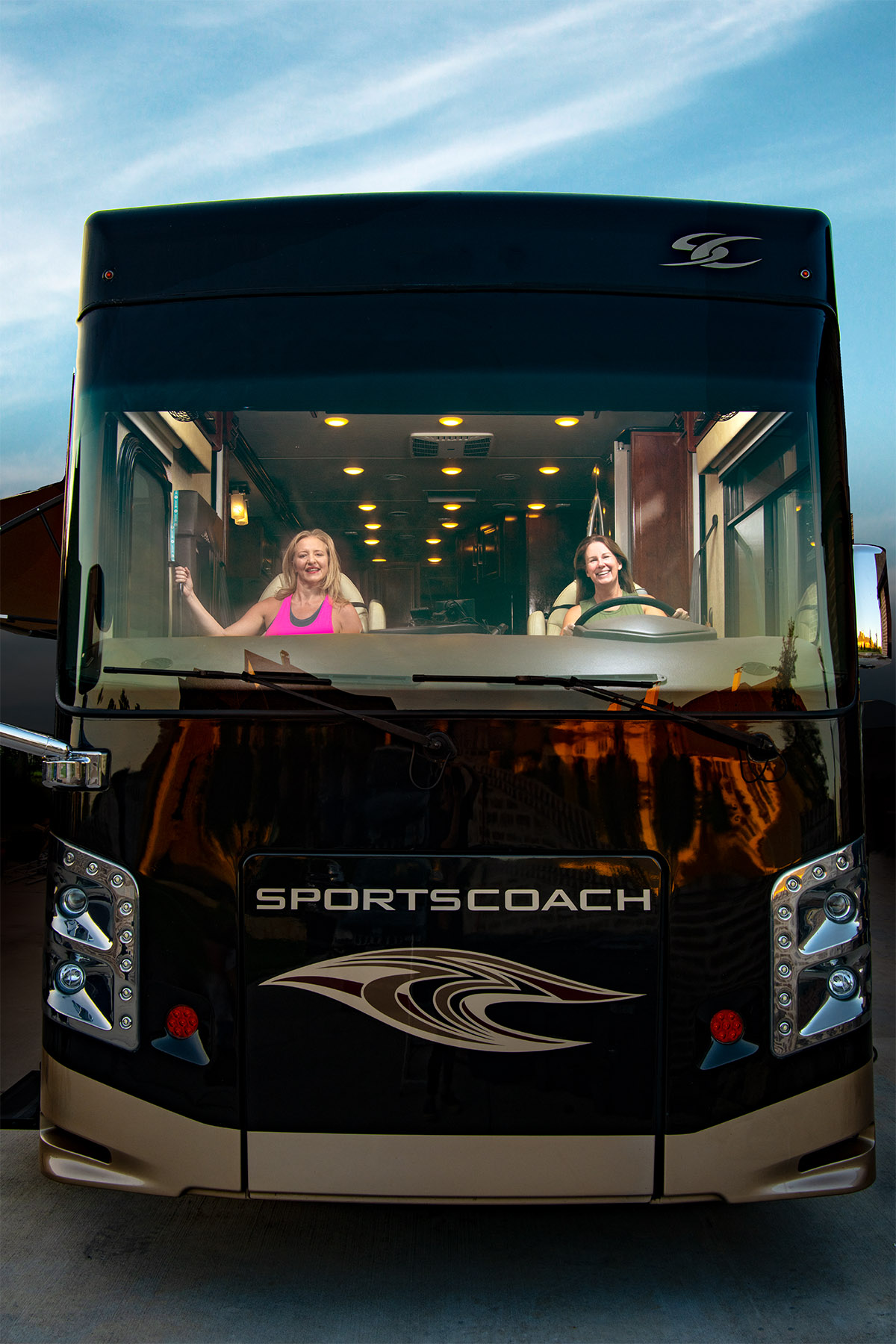
Holly Haggard and Emily Phillips
RVs 4 MDs
Phillips, the mother of three young children and an 18-year-old stepson, was worried about having her husband, an ER doctor in Frisco, in the house. One of her children is less than a year old; another has asthma. But as the pandemic started, hotels in Frisco were closing down and weren’t an appealing option because the family would have to separate. So she put up a post on Facebook looking for a trailer or mobile home to rent. A friend who saw the post put her in touch with Haggard, a mother in Prosper with an RV to spare. Haggard said she didn’t want any payment. She just wanted Phillips to pay the favor forward. From there, the two created the RVs 4 MDs Facebook page, which works to connect owners of trailers, campers, and RVs with frontline workers who need safe and affordable housing.
The page has more than 31,000 members, and it is making matches throughout the United States as well as in Canada, Australia, and Dubai. Joshua Smith, a close friend of Haggard’s, says, “Holly is the reason why so many doctors, nurses, and first responders, not just nationally but worldwide, are able to safely return home after their shifts.”
Dr. Robert Rennaker
UTD
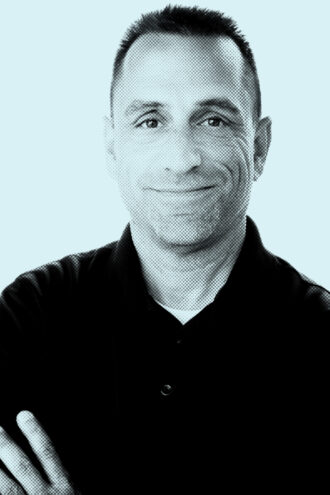
When UTD started having employees work from home, Rennaker began looking for solutions to the problems created by the coronavirus pandemic. The former Marine is the chair of the bioengineering department at UTD, and he was contacted by the deputy medical director for BioTel EMS at UT Southwestern to work on a potential shortage in ventilators. Just a week later, Rennaker developed a machine that could be mass produced with readily available resources: a motorized device that simulates a hand squeezing a manual resuscitator, which is a self-inflating bag that is compressed to help patients who are not breathing. The speed can be manipulated on the motor, and the air volume can be shifted by adjusting an attached rod.
The small machine has an arm attached to a wheel, and as the wheel turns, the arm pushes into the bag and backs out, forcing air through a tube and to the patient. While bag valve masks are functional in emergency situations, they require a healthcare worker to inflate them at all times, so if a patient needs sustained oxygenation and ventilation of CO2 to be able to breathe properly, as is often the case with severe bouts of COVID-19, a machine is needed to keep the airflow steady. A normal mechanical ventilator can cost as much as $50,000, so being able to mimic its activity with easily obtainable supplies can make a difference when treating those with critical respiratory issues. Rennaker’s Manual Resuscitator Assist Device can replicate the ability of the mechanical ventilator at a time when budgets are tight, supply is short, and need is greater than ever.
In addition to the ventilator, Rennaker took on the mask shortage that was impacting so many healthcare facilities around the world. Masks were difficult to find, but they are also irritatingly hot and uncomfortable. Rennaker developed a clear face mask that blows fresh air down from the top of the mask and doesn’t obstruct one’s view, providing safety and comfort. And a doctor at Baylor asked him to build a filtered face mask. He’s working on that device now.
Chain Reaction Robotics Team
Plano Senior High School
When Baylor Scott & White’s Catastrophe Response Team made a public request via Facebook for help repairing the hospital’s powered air purifying respirators (PAPR), Plano Senior High School’s Chain Reaction robotics team jumped in to help. PAPRs purify air for healthcare workers when they need a more complete seal from contaminated air and are an essential part of a hospital worker’s PPE. The team got to work making new face shields for the PAPRs, and one member was even able to make a computer model from one of the old face shields, which allowed them to cut new face shields with their construction equipment. Functioning face shields with PAPRs can be a game changer, replacing up to 100 masks per day for a hospital. In all, the team repaired 232 PAPR face shields for 12 Baylor Scott & White hospitals.
Mary Patefield
Baylor Scott & White Health
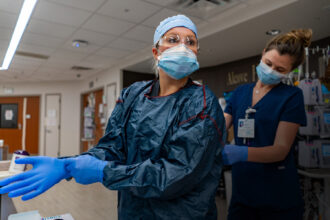
At Dallas-based Baylor Scott & White Health, the largest health system in Texas, Patefield stepped up to solve their PPE problem. With supply chains strained and hospitals, governments, and individuals competing for a limited amount of equipment, Patefield was responsible for finding masks for the system as one of four strategic sourcing directors. Beginning in January, she worked 16-hour days, seven days a week to make sure the system’s 28 hospitals were ready for whatever would come.
Short supplies and tenfold price inflation weren’t the only challenges. She had to root out scammers and eliminate middlemen trying to profit from the crisis and had to identify vendors and exporters who could get supplies in from China. In just three weeks, she set up 150 new vendors, work that normally would have taken several months. As the pandemic raged on, Baylor Scott & White’s hospitals were well stocked and prepared to keep patients and staff safe from the disease.
Joseph Finan
Greenberg Traurig
Finan, a patent agent, stepped up to fill a supply chain gap with a grassroots effort that harnessed the 3D printing community to produce splash shields for medical workers. Using open-source designs, he produced 10 per day and also began printing ear savers, which protect against irritation for those wearing face masks all day. The reusable equipment was donated to frontline healthcare workers.
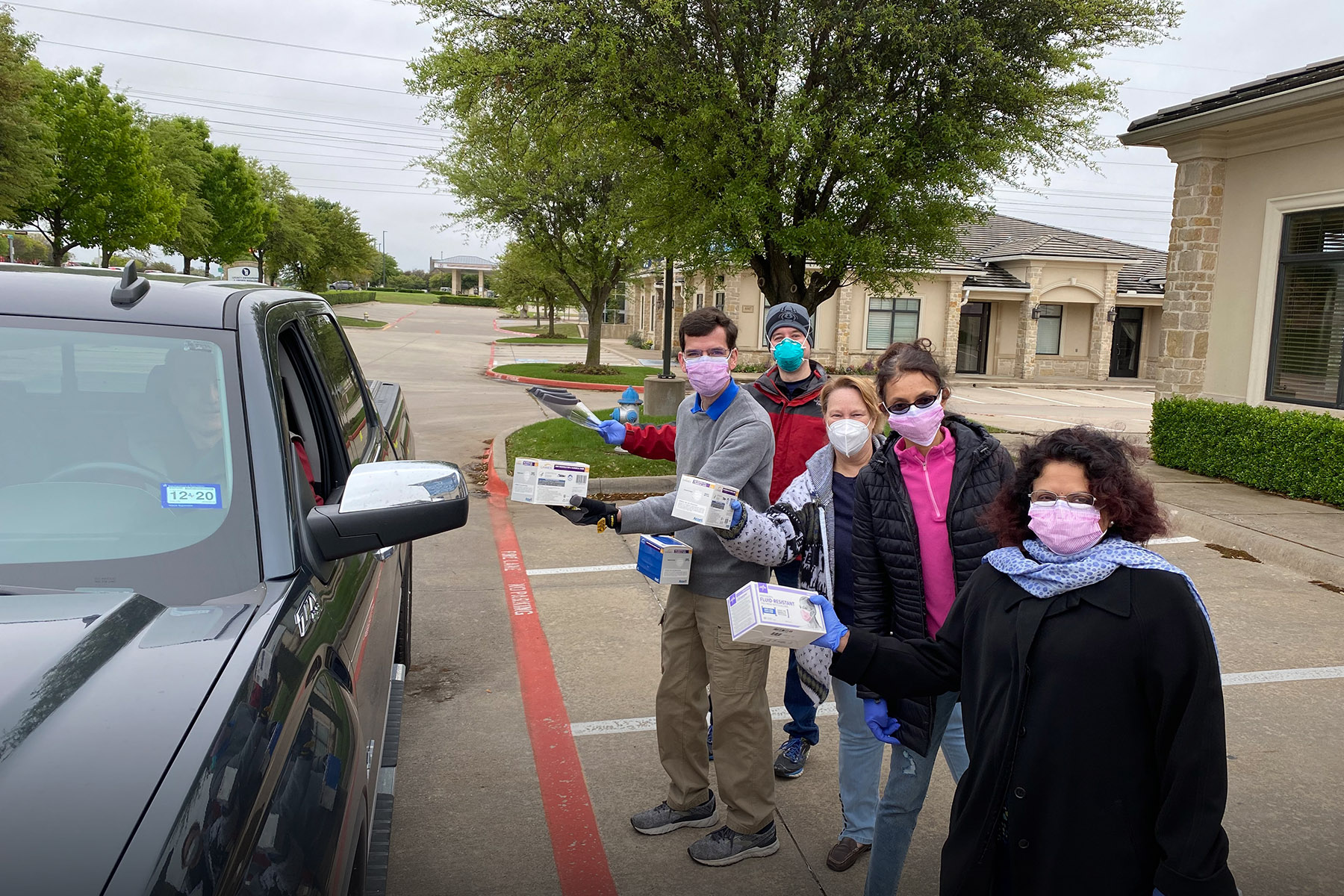
Dr. D.J. Verrett
Innovations Facial Plastic Surgery
Verrett runs Innovations Facial Plastic Surgery in Plano, but when the pandemic ended elective surgeries, he stepped up and began working his connections to secure PPE for members of the Collin-Fannin Medical Society who were still seeing patients. He obtained PPE and distributed it from the parking lot of his office, giving out more than 10,000 KN95 masks, 61,650 N95 masks, 168,400 face masks, 336 gallons of hand sanitizer, 180 gallons of bleach, 9,250 disposable isolation gowns, 4,430 face shields, 20,000 gloves, and much more.
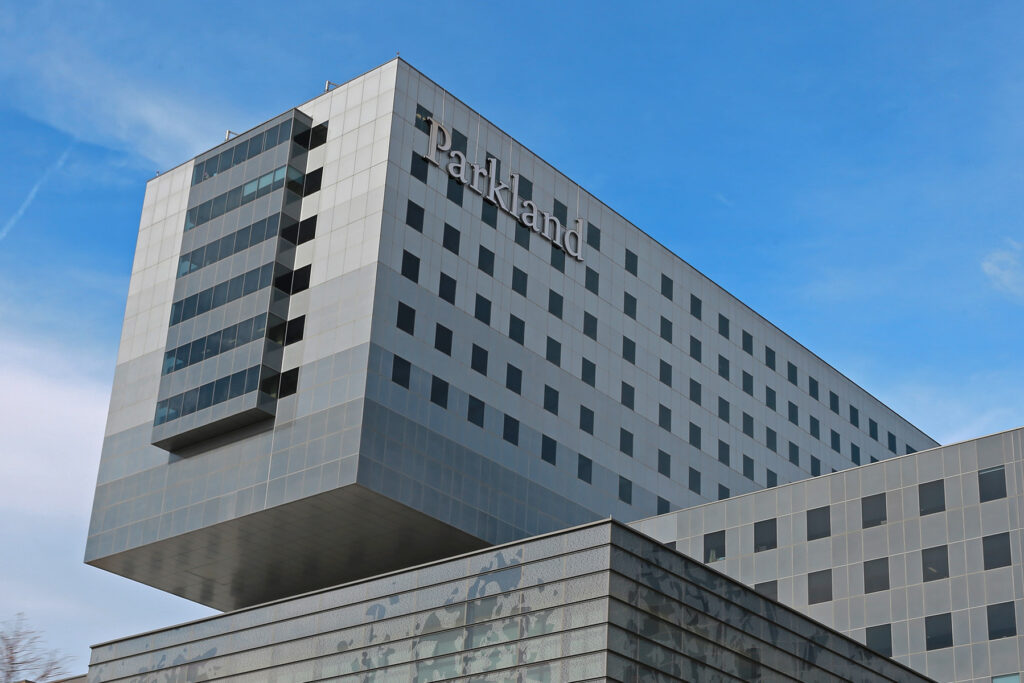
Parkland Hospital
As Dallas County’s public safety net hospital, Parkland knew in February that it was about to be tested. The hospital quickly convened its medical, nursing, and operational stakeholders to map out how it would handle the onslaught. A task force devised a protocol for admitting patients. First move: create one large negative pressure area where COVID-19 patients could be isolated. Facilities staff took just five days to do it.
That space, with more than 100 beds, is now the Tactical Care Unit, affectionately known as the Red Box. A team of about 200 staffers rotates through 12-hour shifts—nurses, critical care physicians, infectious disease specialists, anesthesiologists, respiratory therapists, chaplains, and palliative care specialists. Parkland has since added two additional dedicated wards, expanding its capacity to 168 patients. It also has the ability to house dozens more in other specialized negative pressure rooms throughout the hospital. At this writing, at the end of June, Parkland was caring for 132 COVID-19 patients, more than any hospital in the area, while producing one of the best survival rates in the country.
Meanwhile, as the virus spreads and Dallas County tops with alarming frequency its own records for daily new cases, a team of about 150 providers from Parkland is out on the streets, testing people in difficult conditions. Parkland runs three of the largest testing sites in North Texas. Masked, gloved, and gowned, these staffers spend long hours on their feet, working in the heat with nervous people lined up in their cars. Dr. Donna Persaud and nurse Dolores Diaz were the first to suit up and begin collecting samples. If not for their efforts and the work of countless other Parkland staffers, the numbers and graphs would look far grimmer than they do.
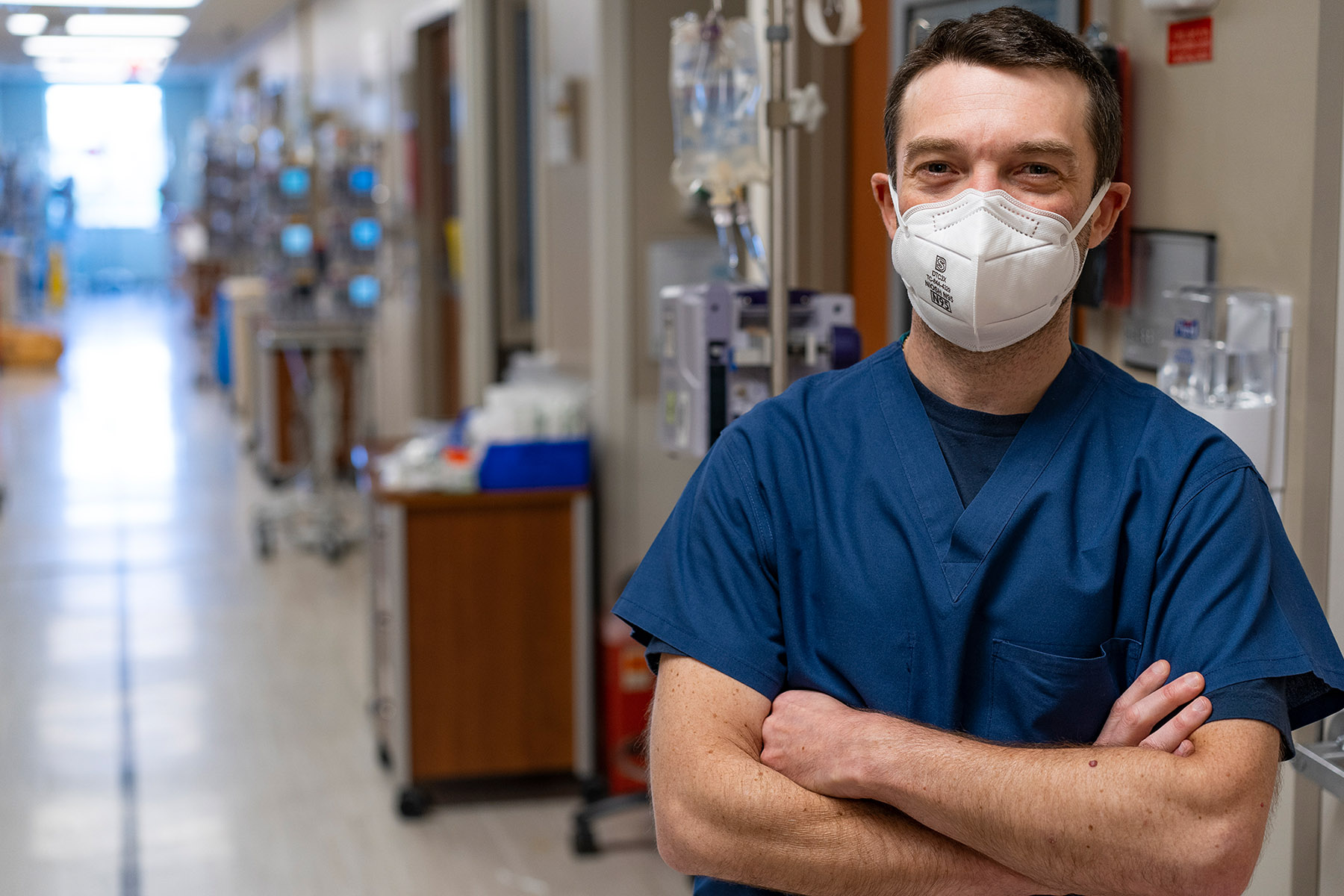
Dr. Ariel M. Modrykamien
Baylor University Medical Center
As Modrykamien monitored the steady march of COVID-19 through China and Europe and then into the United States, he knew his hospital had to completely make itself over to handle what was coming. How it looked, how its nurses and doctors acted, how everything functioned. And it had to happen soon.
Modrykamien, head of critical care for Baylor University Medical Center, was here in 2014, when Ebola threatened the city. But this was a bigger task. The number of ICU beds would need to be increased dramatically. Patient rooms had to be converted to negative pressure to limit the spread of the virus. They’d need storage areas for ventilators and other specialized equipment, spaces to safely put on and remove personal protective equipment, and pathways to transport patients from the emergency room to the COVID care unit without putting anyone in harm’s way.
Modrykamien talked to the ER doctor who cared for victims of the 2017 Las Vegas shooting, the first to use one ventilator on multiple patients.
They built a 36-bed COVID-19 ICU—with the flexibility to expand to 100 beds—in just 48 hours. But being ready went beyond having enough beds. Modrykamien and his team had to adjust to specific roles and responsibilities. For example: since no visitors were allowed, someone on each team was designated to communicate with patients’ loved ones. Protocols and checklists were established for things as complicated as dressing and undressing with PPE, or as seemingly simple as which nurse pushes the elevator button or opens the door when transporting patients between the emergency department and the COVID unit. Modrykamien talked to the ER doctor who cared for victims of the 2017 Las Vegas shooting, the first to use one ventilator on multiple patients, and his team combed through medical journals for answers and new ideas. The result of all this preparation and attention to detail: not a single member of the ICU medical staff contracted the coronavirus. And they were able to save lives.
Dr. Masoud Saman
The Medical Center of Plano
Director of Head and Neck Surgery at The Medical Center of Plano, Saman trained in New York. He thought the pandemic might take him back there. New York Governor Andrew Cuomo sent him an email saying that he would possibly need his help. Although Saman was not eventually summoned to New York, he realized he could do his part right here in Dallas. Due to the quarantine, cases of domestic violence rose, and Saman was called on to provide facial reconstructive surgery for victims. His volunteer efforts in the emergency room exposed him to the crisis firsthand, as he was forced to use the same mask for two and a half weeks as he performed surgeries to save patients. “In the middle of Plano, I felt like I was in the worst medical system in a tiny village or underprivileged area,” he says. “It was just an interesting, scary time.”
Emily Carter
Texas Health Dallas

Even though the man was medically paralyzed and sedated, and on a rotoprone bed (which turns patients on their stomach to help improve lung function), hospital staff would walk by and hear nurse Carter in the isolation unit, gowned up and giving him pep talks every shift. Most of the medical team thought that he was so sick he wouldn’t make it. Carter ignored them. She knew he could pull through.
With permission from the patient’s wife, Carter went through his phone and read hundreds of texts to him from friends saying that they were pulling for him. She played his favorite Pandora stations in his room to create a familiar environment. His wife mentioned he hated having scruff, so Carter donned her PPE and went in to shave his face. Nightly, she would FaceTime his wife from his phone inside the room so that she and his kids could say goodnight. And she called again every single morning to give his wife updates on how the night had gone. She did all this and much more, while the man struggled through a month on life support.
Carter was right. He made it.
City of Dallas and UrgentCare2Go
Data show that social determinants of health such as housing, income, education, and transportation, as well as comorbidities and race, all influence the severity of COVID-19. People of color have been overrepresented in the number of cases and hospitalizations because of lack of access to testing, health disparities, and systemic racism that is being exacerbated by the pandemic. Many in high-risk communities are also essential workers who are unable to work from home, increasing their risk of catching the virus. With testing sites often inaccessible to those without transportation, the city of Dallas partnered with UrgentCare2Go to provide free mobile testing for those who have symptoms and can’t get to a testing site.
Jennifer Lomax-Wood
Presbyterian Hospital of Plano
Let’s call him David. When the 20-year-old presented with severe shortness of breath and fatigue, Lomax-Wood and the other ICU nurses suspected he had COVID-19. His test, though, came back negative. More testing and then a horrible diagnosis: David had metastatic cancer. But with a “no visitor” policy in place, his parents and friends couldn’t console him in person. Lomax-Wood stepped up. Here’s what the nominator wrote:
“Having a son of her own, Jennifer could empathize with his pain, as well as his mother’s emotional pain. David grew to trust Jennifer and actually began to smile when she entered his room. David finally became stable enough to move out of the ICU after about two weeks. Jennifer discovered shortly after his transfer to the medical surgical floor that he was going to have to spend his 21st birthday in the hospital. Without his knowing, she bought a birthday card and passed it out for all the ICU staff to sign with words of encouragement. She also brightened his special day with a balloon and gift card. David was surprised when Jennifer came into his room to celebrate his 21st birthday. They shared smiles and laughter that day. David will undoubtedly always remember this particular birthday, not just because it was his 21st but because of the very special person who made it so unforgettable.”
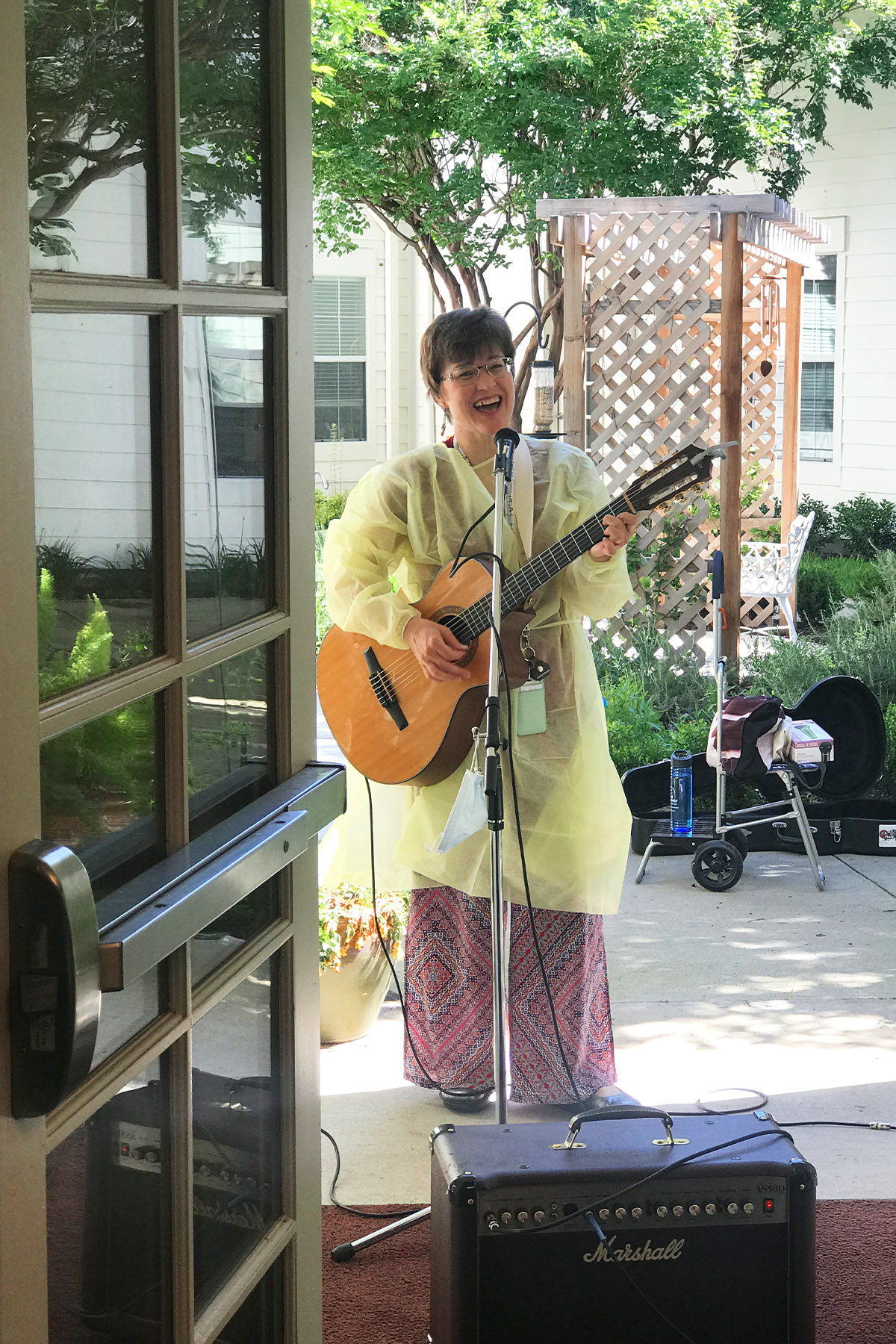
Karen Scholander
Visiting Nurses Association of Texas
Scholander created the VNA’s music therapy program in 2015. With the pandemic, though, she had a challenge: how to play guitar and sing for homebound hospice patients while maintaining social distance. The Front Porch Concert Series allows hospice patients and caregivers to watch through a window as she performs. “Sometimes I only see the patient one time,” she says. “I need to make the most positive impact I can make in the short time I have. There are no do-overs.”
Dr. Jonathan Blacher
Ayik + Berto Dental Specialists
During the early days of the lockdown, dental offices were closed to nonemergency patients. But there were still many dental emergencies, the vast majority of which required a root canal. Blacher, an endodontist, never stopped seeing dental emergency patients, and he worked hard to prevent these dental emergencies from requiring a visit to the ER. In doing so, he saved patients from their pain and from risk of further infection.
Zacharri Polyak
Texas Health Arlington
Polyak, a critical care nurse at Texas Health, moved out of his home at the beginning of the pandemic to protect his wife and two sons and to focus on caring for patients in the hospital’s COVID ICU.
That’s where he met the woman. She came into the ER 30 weeks pregnant and so sick that doctors decided she needed to be on a ventilator. The baby was delivered via C-section and sent to the NICU, while the Spanish-speaking mother—when she was stable enough to be moved and after she had officially tested positive—was transferred to the COVID ICU.
There, she was alone, surrounded by doctors and nurses who mostly spoke only English (one ICU nurse, Rose Guzman, was able to spend time with her, encouraging and comforting her in Spanish). She hadn’t seen her baby. She had no postpartum support or lactation consult; Labor and Delivery would not come because they were afraid to carry the virus back to the babies and moms on their floor. She got mastitis and became withdrawn and depressed once she was finally awake enough to realize what had happened.
Polyak knew at least a little of what she was going through. Last year, his wife gave birth to a son who spent his first 17 days in the NICU. So he went to work. The NICU manager said she’d need two negative tests and seven days of the mother being symptom free before she could see the baby in person, so he got her set up with the Angel Eye app, allowing her round-the-clock viewing access. He got someone from lactation to call and talk to her in Spanish. Members of the ICU even brought her cabbage leaves and a binder to help dry up her milk.
But more than anything, he was just there. He got someone to come in and translate, then he sat with the woman and told her his story, how he and his wife had their baby by emergency C-section, too, the nights they spent in the NICU. He told her that she was not alone and that he would do everything he could to support her.
Klava St. John
Texas Health Southwest
 The 88-year-old patient was waiting for test results for COVID-19 and not doing well. Not only was he in a terrifying situation, but he spoke only Russian and couldn’t grasp what his caregivers, anonymous and practically faceless in their personal protective equipment, were trying to communicate. He was lethargic, giving one-word answers and struggling to breathe, and caregivers were having problems assessing his neurological state. Due to COVID-19 visitor restrictions, his daughters could not come in to visit.
The 88-year-old patient was waiting for test results for COVID-19 and not doing well. Not only was he in a terrifying situation, but he spoke only Russian and couldn’t grasp what his caregivers, anonymous and practically faceless in their personal protective equipment, were trying to communicate. He was lethargic, giving one-word answers and struggling to breathe, and caregivers were having problems assessing his neurological state. Due to COVID-19 visitor restrictions, his daughters could not come in to visit.
That’s where nurse St. John came in. She’s a native Russian who moved with her family to the United States when she was 12. The minute she spoke to him, the elderly patient began to respond. St. John learned the man was what she calls a “true Russian.” He had never owned a car, walked everywhere he went, cooked for himself daily, and was very independent. He had never been in any hospital before.
Over the next few days, his condition continued to decline. As he grew sicker, St. John took on the difficult role of helping his daughters decide whether he should be kept alive using life support or allowed to die naturally. She spoke with them in Russian on the phone. One daughter wanted only for her father to be comfortable and felt he wouldn’t be if he were on life support. But the other was struggling, St. John says. “She got very emotional and they couldn’t quite meet each other on the same page,” she says.
With St. John’s help, the hesitant daughter was able to talk to her father on the phone. Near the end of the conversation, he told her, “I love you, my daughter.” When she asked if he was in pain, he responded, “The only thing that’s in pain is my soul.” The daughter realized it would soon be time to let him go—and that she could.
A few hours later, the patient took a turn for the worse. St. John reached out to both daughters and they decided on a “do not resuscitate” order.
“Without her help, the patient would’ve been intubated and certainly would have died regardless of our care,” says Dr. Kevin Conley, the pulmonologist who cared for the man, “but it would have potentially exposed multiple other people and utilized resources in a futile effort and likely would have increased the patient suffering at the end of his life.”


